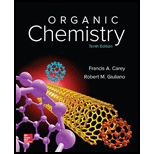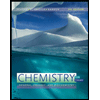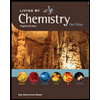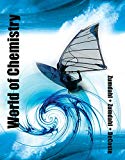
Organic Chemistry - Standalone book
10th Edition
ISBN: 9780073511214
Author: Francis A Carey Dr., Robert M. Giuliano
Publisher: McGraw-Hill Education
expand_more
expand_more
format_list_bulleted
Concept explainers
Textbook Question
Chapter 1.1, Problem 1P
How many electrons does carbon have? How many are valence electrons? What third-row element has the same number of valence electrons as carbon?
Expert Solution & Answer
Want to see the full answer?
Check out a sample textbook solution
Students have asked these similar questions
Carbon is contained in almost all organic material and biological life. Why is carbon so special? Hint: carbon has 4 valence electrons.
How many valence electrons does each of the following atoms have?
titanium, ? = 22
iodine, ? = 53
radium, ? = 88
manganese, ? = 25
Chapter 1 Solutions
Organic Chemistry - Standalone book
Ch. 1.1 - How many electrons does carbon have? How many are...Ch. 1.1 - Referring to the periodic table as needed, write...Ch. 1.2 - Species that have the same number of electrons are...Ch. 1.2 - Which of the following ions possess a noble gas...Ch. 1.2 - Prob. 5PCh. 1.3 - Prob. 6PCh. 1.3 - Problem 1.7 All of the hydrogens are bonded to...Ch. 1.4 - Problem 1.8 In which of the compounds...Ch. 1.4 - Indicate the direction of the dipole for the...Ch. 1.5 - Prob. 10P
Ch. 1.5 - The following inorganic species will be...Ch. 1.5 - Prob. 12PCh. 1.6 - Prob. 13PCh. 1.6 - Problem 1.14 Nitrosomethane and formaldoxime both...Ch. 1.6 - Prob. 15PCh. 1.7 - All of the bonds in the carbonate ion (CO32-) are...Ch. 1.7 - Prob. 17PCh. 1.8 - Prob. 18PCh. 1.8 - Prob. 19PCh. 1.9 - Sodium borohydride, NaBH4, has an ionic bond...Ch. 1.9 - Prob. 21PCh. 1.10 - Which of the following compounds would you expect...Ch. 1.11 - Using the curved arrow to guide your reasoning,...Ch. 1.11 - Prob. 24PCh. 1.11 - Prob. 25PCh. 1.12 - Prob. 26PCh. 1.12 - Prob. 27PCh. 1.12 - Prob. 28PCh. 1.12 - Prob. 29PCh. 1.12 - Prob. 30PCh. 1.13 - Which is the stronger acid, H2O or H2S? Which is...Ch. 1.13 - Prob. 32PCh. 1.13 - Prob. 33PCh. 1.13 - Hypochlorous and hypobromous acid (HOClandHOBr)...Ch. 1.13 - Prob. 35PCh. 1.13 - Prob. 36PCh. 1.14 - What is the equilibrium constant for the following...Ch. 1.14 - Prob. 38PCh. 1.14 - Prob. 39PCh. 1.15 - Write an equation for the Lewis acid/Lewis base...Ch. 1 - Write a Lewis formula for each of the following...Ch. 1 - Prob. 42PCh. 1 - Write structural formulas for all the...Ch. 1 - Prob. 44PCh. 1 - Expand the following structural representations so...Ch. 1 - Each of the following species will be encountered...Ch. 1 - Consider Lewis formulas A, B, and C: H2 C -NN:...Ch. 1 - Prob. 48PCh. 1 - Prob. 49PCh. 1 - Prob. 50PCh. 1 - Prob. 51PCh. 1 - Prob. 52PCh. 1 - Prob. 53PCh. 1 - Prob. 54PCh. 1 - Which compound in each of the following pairs...Ch. 1 - With a pKa of 11.6, hydrogen peroxide is a...Ch. 1 - The structure of montelukast, an antiasthma drug,...Ch. 1 - One acid has a pKa of 2, the other has a pKa of 8....Ch. 1 - Calculate Ka for each of the following acids,...Ch. 1 - Rank the following in order of decreasing acidity....Ch. 1 - Rank the following in order of decreasing...Ch. 1 - Consider 1.0 M aqueous solutions of each of the...Ch. 1 - Prob. 63PCh. 1 - Prob. 64PCh. 1 - Prob. 65PCh. 1 - Prob. 66PCh. 1 - Prob. 67PCh. 1 - Prob. 68PCh. 1 - Amide Lewis Structural Formulas Lewis formulas are...Ch. 1 - Amide Lewis Structural Formulas Lewis formulas are...Ch. 1 - Amide Lewis Structural Formulas Lewis formulas are...Ch. 1 - Prob. 72DSPCh. 1 - Amide Lewis Structural Formulas Lewis formulas are...Ch. 1 - Amide Lewis Structural Formulas Lewis formulas are...
Additional Science Textbook Solutions
Find more solutions based on key concepts
141. Design a device that uses as electrochemical cell to determine amount of
in a sample water Describe, in...
Chemistry: Structure and Properties (2nd Edition)
Write the electron configurations far each of the following elements: (a) Sc. (b) Ti. (c) Cr. (d) Fe. (e) Ru
Chemistry by OpenStax (2015-05-04)
The active ingredient in Tylenol and a host of other over-the-counter pain relievers is acetaminophen (C8H9NO2)...
Chemistry: Atoms First
Draw a Lewis structure for each covalent molecule. a. HBr b. CH3F c. H2O2 d. N2H4 e. C2H6 f. CH2Cl2
Principles of General, Organic, Biological Chemistry
Which of the following solutions has the higher molarity? 10 ppm KI in water or 10,000 ppb KBr in water 0.25 ma...
CHEMISTRY-TEXT
Fully developed conditions are known to exist for water flowing through a 25-nim-diameer tube at 0.01 kg/s and ...
Fundamentals of Heat and Mass Transfer
Knowledge Booster
Learn more about
Need a deep-dive on the concept behind this application? Look no further. Learn more about this topic, chemistry and related others by exploring similar questions and additional content below.Similar questions
- How many valence electrons are needed to complete the outer valence shell of sulfur? a. 1 b. 2 c. 3 d. 4arrow_forwardLook at the periodic table and tell how many electrons are in the valence shell of the following elements: a. element number 35 b. Zn c. strontium d. the second element in group VA (15)arrow_forwardHow many electrons are shown in each element’s electron-dot structure? a. carbon c. calcium b. iodine d. galliumarrow_forward
- 7.20 Draw the Lewis dot symbol for each of the following atoms, (a) boron, (b) fluorine, (c) selenium, (d) indiumarrow_forwardExplain why (a) negative ions are larger than their corresponding atoms. (b) scandium, a transition metal, forms an ion with a noble-gas structure. (c) electronegativity decreases down a group in the periodic table.arrow_forwardWrite the complete electron configuration for each of the following representative elements. a. Period 2 element with one valence electron b. Period 2 element with six valence electrons c. Period 3 element with seven valence electrons d. Period 3 element with three valence electronsarrow_forward
arrow_back_ios
arrow_forward_ios
Recommended textbooks for you
 Chemistry for Today: General, Organic, and Bioche...ChemistryISBN:9781305960060Author:Spencer L. Seager, Michael R. Slabaugh, Maren S. HansenPublisher:Cengage LearningChemistry: Matter and ChangeChemistryISBN:9780078746376Author:Dinah Zike, Laurel Dingrando, Nicholas Hainen, Cheryl WistromPublisher:Glencoe/McGraw-Hill School Pub Co
Chemistry for Today: General, Organic, and Bioche...ChemistryISBN:9781305960060Author:Spencer L. Seager, Michael R. Slabaugh, Maren S. HansenPublisher:Cengage LearningChemistry: Matter and ChangeChemistryISBN:9780078746376Author:Dinah Zike, Laurel Dingrando, Nicholas Hainen, Cheryl WistromPublisher:Glencoe/McGraw-Hill School Pub Co General, Organic, and Biological ChemistryChemistryISBN:9781285853918Author:H. Stephen StokerPublisher:Cengage Learning
General, Organic, and Biological ChemistryChemistryISBN:9781285853918Author:H. Stephen StokerPublisher:Cengage Learning Living By Chemistry: First Edition TextbookChemistryISBN:9781559539418Author:Angelica StacyPublisher:MAC HIGHER
Living By Chemistry: First Edition TextbookChemistryISBN:9781559539418Author:Angelica StacyPublisher:MAC HIGHER World of Chemistry, 3rd editionChemistryISBN:9781133109655Author:Steven S. Zumdahl, Susan L. Zumdahl, Donald J. DeCostePublisher:Brooks / Cole / Cengage Learning
World of Chemistry, 3rd editionChemistryISBN:9781133109655Author:Steven S. Zumdahl, Susan L. Zumdahl, Donald J. DeCostePublisher:Brooks / Cole / Cengage Learning


Chemistry for Today: General, Organic, and Bioche...
Chemistry
ISBN:9781305960060
Author:Spencer L. Seager, Michael R. Slabaugh, Maren S. Hansen
Publisher:Cengage Learning

Chemistry: Matter and Change
Chemistry
ISBN:9780078746376
Author:Dinah Zike, Laurel Dingrando, Nicholas Hainen, Cheryl Wistrom
Publisher:Glencoe/McGraw-Hill School Pub Co

General, Organic, and Biological Chemistry
Chemistry
ISBN:9781285853918
Author:H. Stephen Stoker
Publisher:Cengage Learning

Living By Chemistry: First Edition Textbook
Chemistry
ISBN:9781559539418
Author:Angelica Stacy
Publisher:MAC HIGHER

World of Chemistry, 3rd edition
Chemistry
ISBN:9781133109655
Author:Steven S. Zumdahl, Susan L. Zumdahl, Donald J. DeCoste
Publisher:Brooks / Cole / Cengage Learning
The Bohr Model of the atom and Atomic Emission Spectra: Atomic Structure tutorial | Crash Chemistry; Author: Crash Chemistry Academy;https://www.youtube.com/watch?v=apuWi_Fbtys;License: Standard YouTube License, CC-BY